Vegaøyan - The Vega Archipelago: The Vega Archipelago is a group of islands in the Norwegian Sea. The archipelago is situated off the west coast of Norway. The numerous islands, islets and skerries of the Vega Archipelago are an inhospitable but magnificent environment close to the Arctic Circle. The archipelago has given fisherman-farmers and hunters a frugal living for more than 1500 years, based mainly of fishing and harvesting down and eggs from wild eider duck nests. The 6500 small islands of the Vega Archipelago (Vegaøyan in Norwegian) surrounds the main island of Vega. The Vega Archipelago is not famous for large monuments or magnificent buildings, its value lies in the cultural traditions, the peace and tranquility of the beautiful and breathtaking nature. The Vegaøyan - Vega Archipelago is the most important wintering area for seabirds in the Nordic region. By BirdLife International, the Vega Archipelago was recognised as an important bird area (IBA). The Vegaøyan - The Vega Archipelago gained the status as a UNESCO World Heritage in 2004.
www.werelderfgoedfotos.nl © Copyright World Heritage Photos
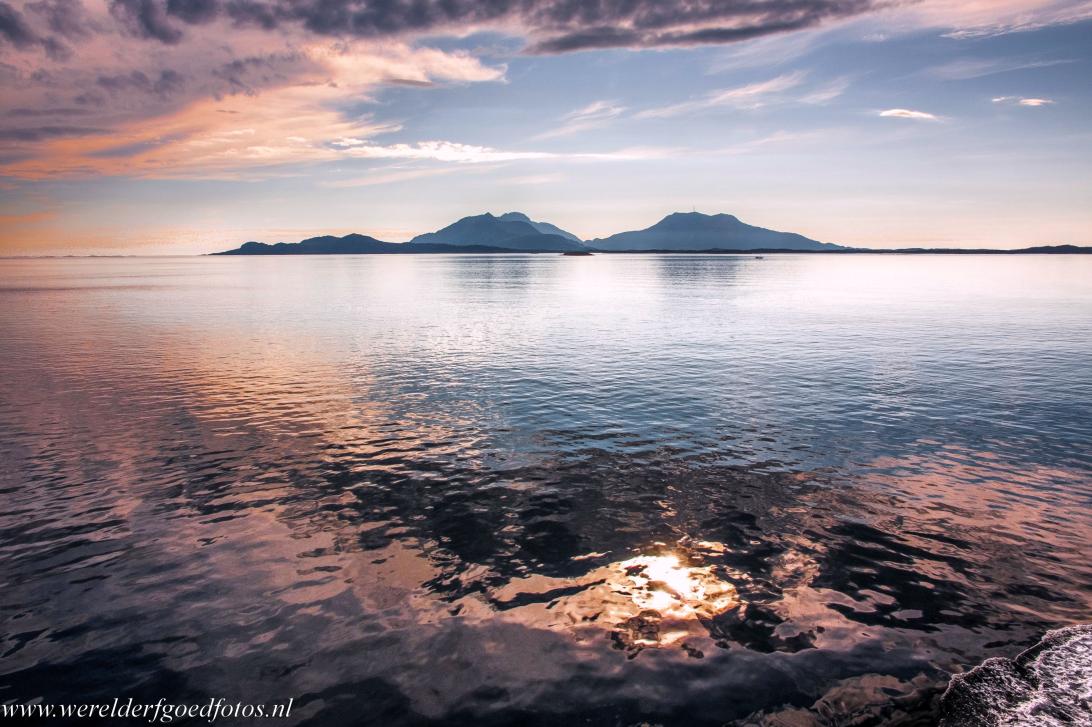
A breathtaking sunset over the Vega Archipelago and the Norwegian Sea. Parts of the west coast of Norwayt are fringed by a strand flat: numerous low islands and scattered coastal peaks. This type of landscape is only found in a few parts in the world, the Vega Archipelago is one of those landscapes, situated off the coast of Helgeland in Norway.

A breathtaking sunset over the Vega Archipelago and the Norwegian Sea. Parts of the west coast of Norwayt are fringed by a strand flat: numerous low islands and scattered coastal peaks. This type of landscape is only found in a few parts in the world, the Vega Archipelago is one of those landscapes, situated off the coast of Helgeland in Norway.

The Vega Archipelago - Vegaøyan in Norwegian: The small ferry landing on Ylvingen, an island just off the Norwegian coast. The ferry sails from Horn, about 14 km north of Brønnøysund, to the islands of Ylvingen and Vega. The islands of the Vega Archipelago with local production of eider down are all forbidden to land during the eider duck nesting season and molting period.
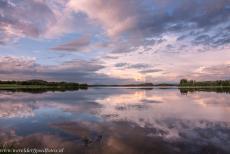
Vegaøyan - The Vega Archipelago: A breathtaking sunset on Vega Island, the main island of the archipelago. The archipelago is not famous for large monuments or magnificent buildings, its value lies in the cultural traditions, the peace and tranquility of the amazing nature. Vegaøyan - The Vega Archipelago was declared a UNESCO World Heritage in 2004.
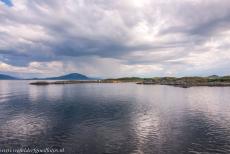
Vegaøyan - The Vega Archipelago: The 6500 islands, islets and skerries of the Vega Archipelago are an inhospitable but magnificent environment close to the Arctic Circle. The Vegaøyan has given fisherman / farmers / hunters a frugal living for more than 1500 years, based mainly of fishing and harvesting down and eggs from wild eider duck nests.

Vegaøyan - The Vega Archipelago: The peace and tranquility of the beautiful nature on the Vega Archipelago, seen from the campground on Vega Island. The archipelago is the most important wintering area for seabirds in the Nordic region such as great cormorant, purple sandpiper, sea eagle, common loon, common eider, European shag, barnacle goose and the black guillemot.

Vegaøyan - The Vega Archipelago: The Gullsvågfjellet Mountain. The radar on the summit of the Gullsvågfjellet is not included in the UNESCO World Heritage. The higher mountains on Vega are situated on the west side of Vega Island, among them are the Trollvasstinden (804 metres) and the Gullsvågfjellet (737 metres), they act as a barrier between the island and the Norwegian Sea.
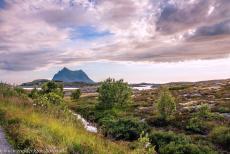
Vegaøyan - The Vega Archipelago: Overlooking the island of Søla from the Holandsosen Nature Reserve. The island of Søla is situated 1.8 km west of Vega. The Holandsosen Nature Reserve is a varied wetland area between the villages of Holand and Viksås. The mountains Trollvasstinden and Gullsvågfjellet are situated on the west coast of the island of Vega.

Vegaøyan - The Vega Archipelago: Evening falls over the island of Vega, the islands of the Vega Archipelago and mountains of mainland Norway in the distance. The 6500 small islands of the Vega Archipelago, or Vegaøyan in Norwegian, surrounds the main island of Vega. Vega Island is situated about 13 km off the Norwegian coast.

Vegaøyan - The Vega Archipelago: The tiny fishing village of Nes on Vega Island. Dried fish is still an important export product of Norway. The small local E-huset Museum, E-House Museum, is housed in an old wharf house at the village of Nes, the musem explaines everything there is to know about the eider duck and harvesting the eiderdown.
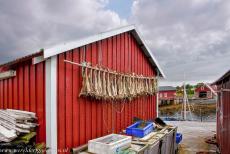
Vegaøyan - The Vega Archipelago: Dried fish on the wall of a fisherman's house in the village of Nes on Vega Island. The fish is dried by wind and cold air. The method is cheap and dried fish has a storage life of several years and can last without refrigeration many years. Dried fish is a traditional food of Norway. Most of the houses of the Vega Archipelago are painted in Falu Red.
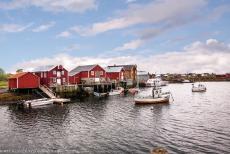
Vegaøyan - The Vega Archipelago: Warehouses on the quay of the village of Nes. The village of Nes is a small fishing village situated on the main island Vega. The E-huset Museum is situated in Nes, it is dedicated to eider ducks and eiderdown harvesting, and also gives insight into the history and tradition of processing down into eiderdown duvets.
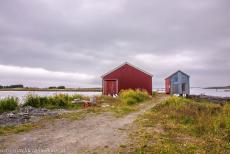
Vegaøyan - The Vega Archipelago: Several isolated fisherman's huts on the island of Vega. For centuries, fishing and harvesting down and eggs from the wild eider duck nests were the main occupations on the Vega Archipelago. It is not permitted to land on several islands of the Vega Archipelago during the eider duck nesting season.
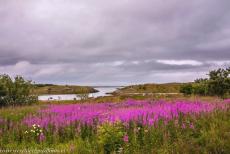
Vegaøyan - The Vega Archipelago: A small field of vibrant and blooming rosebay willowherb, or fireweed. The value of the Vega Archipelago lies in the cultural traditions and the tranquility and peace of the breathtaking nature. The archipelago is a heaven for birdwatchers, as many as 228 bird species have been observed in the Vega Archipelago.

Vegaøyan - The Vega Archipelago: The Vega Kirke is the Parish Church of the island of Vega, the church located in Gladstad. The wooden church was built in 1864 and can accommodate about 430 people. Gladstad is the capital city of Vega, the main island of the Vega Archipelago. Nearly all the islands of the Vega Archipelago are uninhabited.

Vegaøyan - The Vega Archipelago: The ferry between the mainland of Norway, Vega Island and Ylvingen Island. Vega is the main island of the Vega Archipelago, it is situated about 13 km off the Norwegian coast. Several bunkers and tunnels from the Second World War are situated on Ylvingen Island. The Vega Archipelago is called in Norwegian 'Vegaøyan'.

Vegaøyan - The Vega Archipelago: Leaving the island of Vega and the imposing and spectacular scenery of the open sea, the small islands and the magnificent isolated hills of the archipelago. Most of the islands of the Vega Archipelago are uninhabited. Vegaøyan - The Vega Archipelago was inscribed on the UNESCO World Heritage List in 2004.
